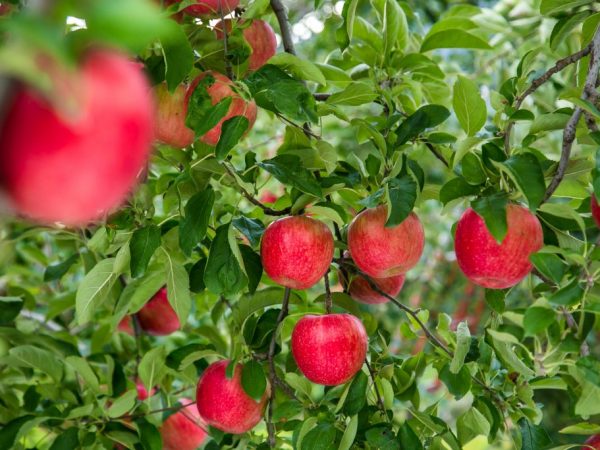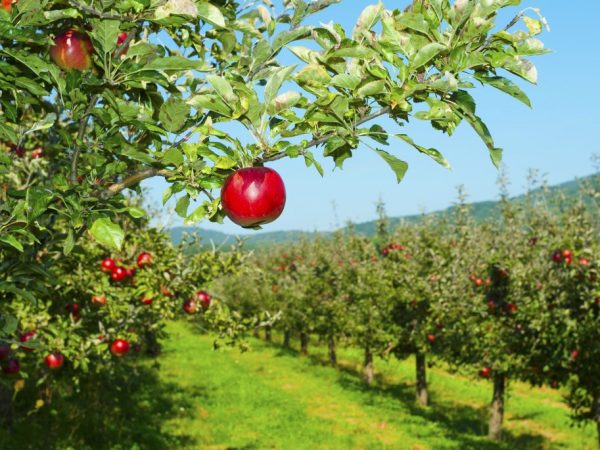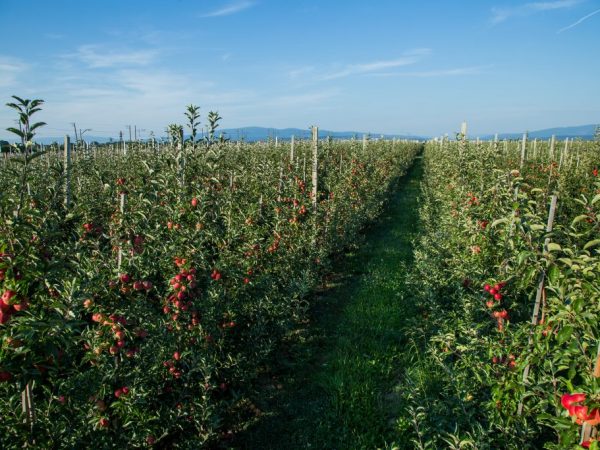Varietal description of the "Zvezdochka" apple tree
The Zvezdochka apple tree is a unique hybrid bred by the breeder Chernenko from two varieties of apples, Anis Aloi and Pepinka Litovskaya. Gardeners have appreciated this vigorous, thermophilic and spreading tree that yields delicious scarlet fruits.
- Breeding history
- Variety characteristic
- Description of fruits
- Taste characteristic
- Yield
- Pollination
- Transportability
- Frost resistance
- Advantages of the variety
- disadvantages
- Landing rules
- Landing dates
- Choosing a landing site
- Site preparation
- Preparation of seedlings
- Landing technology
- Features of ripening and fruiting
- The beginning of fruiting
- The timing of flowering and ripening of fruits
- Harvesting and storage
- Disease and pest resistance
- Subspecies and variants
- On a dwarf rootstock
- Columnar
- Winter variety
- Growing regions
- Gardeners reviews

Varietal description of the "Zvezdochka" apple tree
Breeding history
Professor Chernenko was engaged in breeding the Zvezdochka variety, who was able to combine two most powerful types of apples.
The fruits have a pronounced ribbing, thanks to which the variety got its name.
The new species has become a truly worthy brainchild of its progenitors. The tree turned out to be tall, branched and sweeping. With this characteristic, the apple tree is absolutely unstable to frost, therefore, it can be rarely found in the northern regions.
Variety characteristic
The asterisk reaches up to 4 m in height, a young apple tree has a rounded crown, but over the years, when the branches grow, it can change its shape and sag.
The general structure is made up of a large number of small branches with dense jagged foliage.
Description of the variety:
- ripens in early autumn;
- fruits are stored for up to 7 months;
- the peak of fertility in the 13th year;
- you can collect up to 100 kg of apples from a tree;
- regular yield.
Description of fruits
The apple tree bears round and smooth fruits, the weight of one reaches 120 g. The cover of the apple is even, bright red. The peduncles are thin and low. The taste of the fruit is bright and deep, with a pronounced sweet and sour part.
Taste characteristic
Apples are table and dessert. According to the description, they have a rich taste and harmoniously dilute the sweetness with a slight sourness.
The color of the flesh is greenish, with pinkish tints. The surface of the fruit is smooth and moderately covered with natural wax.
Yield

The Zvezdochka variety has a high yield.
The tree bears fruit regularly and in large quantities. One adult tree can bring from 80 kg to 200 kg per year.
Fruits are medium in size, weight 90-150 g.
The history records fruitful years when one tree could bring a record number of apples - 250 kg.
Pollination
Gardeners know all the intricacies of working with Zvezdochka and be sure to take into account the fact that this apple variety is winter and needs pollinators.
It is better to plant such varieties in the neighborhood: Antonova, Zhigulevskoe or Bogatyr - this is how the gardener gets excellent tree growth.
It is important to note that the best ratio with pollinating trees is 1: 3.
Transportability
Apples perfectly tolerate transportation, are stored for a long time and keep their presentation well.
Having a high resistance to the appearance of fungal diseases, they can be kept for a long time even outside the refrigerator.
It is better to transport the fruits and store them in wooden boxes, stacked in one layer. If the box is deep, it is allowed to lay in 3 layers, but provided that the wood is dry.
Frost resistance
The Zvezdochka apple tree has average resistance to low temperatures. In extremely cold winters, when the temperature drops to -25 ° C, it can freeze over and not bear fruit in spring.
To avoid rigor mortis, mulch should be used, and especially responsible gardeners additionally insulate the trunk.
Advantages of the variety
- powerful taste;
- high liquidity in the market;
- long storage;
- regular yield.
disadvantages
Before planting these fruitful trees, you need to know about all the nuances and disadvantages: the annual reduction in the number of apples, as well as a decrease in the quality of the fruits and their size.
All these characteristics apply only to mature trees: the young will delight the garden with its beauty and tasty fruits for a long time.
Landing rules

Proper care will allow you to get a good harvest.
You should be especially careful when planting a tree. We must not forget that this variety is winter, which means that the soil must be prepared at the onset of April or when the snow has completely melted.
The first years after planting, you need to especially carefully and carefully monitor it. Care should include regular feeding, timely pruning and regular watering.
Landing dates
When planting a tree after winter, be sure to make sure that the snow has melted and the frost has passed. For a young tree, a specially prepared hole is needed, the depth of which should be about 80-100 cm. It is pre-filled with sawdust, peat and mineral additives. Before fertilizing, you need to make sure that nitrogen is not included in the fertilizing, otherwise the tree can be rashly destroyed. It is better to use nitrogen fertilizers in the fall, in the spring they have a detrimental effect on the roots.
When the pit is prepared, planting begins. It does not differ from the classic planting of fruitful trees. It is enough to fluff the roots well, define them in the center of the hole and cover them with earth. After the soil roller is formed, the tree is tied up.
Choosing a landing site
The main characteristic of apples is their wide population.
The habitat is the central regions of Russia, Ukraine and Belarus.
Seedlings do not take root in areas with severe winters. Having good and fertile soil, the gardener may not get hung up on choosing a planting site. The main thing is the rich composition of the soil for effective fruit ripening.
A prerequisite is planting in the southern part of the garden, the tree is sun-loving and should not be in the shade.
Site preparation
Saplings love wide and deep holes. Make sure that it is about 1 m deep and about 50-80 cm wide.
First, you need to fertilize the soil and create a cushion of tyrsa or sawdust, you can add hay and bark, and also lay a thick layer of mulch (this will protect the roots from freezing and retain the moisture of the entire root system).
Preparation of seedlings
The roots of the seedling should be well fluffed, having a dense system, do it carefully to avoid damage to the still immature root processes.
Landing technology
The tree is placed in a prepared and fertilized hole, covered with earth. The ground must be consistently tamped until it is aligned with the general level of the site. The root collar should be raised by 5 cm.
After the tree is firmly in the soil and tied up, you need to dig additional grooves through which excess moisture will come out.
Features of ripening and fruiting

Fruits can also ripen after harvest
Winter apple trees bear fruit in the fall. After planting, the apple tree will bear its first fruits in 6 years.
If it is planted on a dwarf rootstock, then the first harvest can be expected in 3 years.
The fertility of the variety is average, with a moderate amount of apples. From an adult tree, about 100 kg are harvested per year.
Fruits ripen and after harvest, if you harvested them in September, then by October it is already quite possible to use them.
The beginning of fruiting
Before flowering, namely before the foliage appears, it is imperative to prune.
By removing excess branches and dried twigs, the gardener ensures high-quality flowering and prevents the tree from reducing the size of the fruit annually. The trees begin to bear the first fruits, on average after 5 years.
The first harvest will be small, but it grows every year.
The timing of flowering and ripening of fruits
This fruit variety belongs to late-ripening apple trees and yields much later than other trees. The buds open, and flowering begins only in May.
Harvesting and storage
Gives a fully ripe harvest in September. You can collect it by October, but if the apple tree begins to show its fruits, you should not delay the collection.
The filling can also ripen in the cellar or in special wooden boxes. It will not deteriorate and lose its presentation thanks to the generous wax coating. It preserves the fruit as long as possible and protects it from rotting and wilting.
Disease and pest resistance
The filling is known for its invulnerability from scab, but it is still recommended to carry out treatment with fungicides in order to avoid infection with other fungal diseases and to protect against viruses.
The most popular means of struggle:
- Horus;
- Topaz;
- Fundazol;
- Karbofors.
Prevention is carried out in three stages: in the spring, before the appearance of the kidneys; when flowering; and then in the fall, before the cold snap.
Examine the underside of the trunk and branches carefully: this is how an experienced gardener can diagnose the presence of a fungus or an accumulation of insects and remove them.
Subspecies and variants

The variety is very popular.
Apple trees "Zvezdochki" made a real sensation in the gardens, they were so fond of that many tried to improve the variety and get even more high-quality fruits.
A number of successful attempts and experiments with planting methods have formed three selection options.
On a dwarf rootstock
Trees grown on a dwarf rootstock reach a height of 3 m. They do not have such a dense and lush crown, therefore, they look more graceful.
These trees do not differ at all in the quality of the fruit. The crown is much easier to care for, prune and harvest.
This subspecies is resistant to low temperatures, and the seedlings are grafted much faster and can bear fruit after 2-3 years.
They can be harvested several weeks earlier, they ripen a little faster than normal ones. Fruiting period up to 20 years.
Columnar
Pouring Zvezdochka grown on a columnar rootstock is a tree with sparse and straight branches.
Apples are found along the length of the trunk. This form fell in love with gardeners because now the number of trees in the garden could be increased, thin and without crowns, they grow successfully, adjacent to other trees.
The fruits are large, ripen in large quantities. In 13 years, the trees will have to be renewed, they do not live longer.
Winter variety
Winter Stars have deservedly received the name of their subspecies.
They are able to withstand low temperatures and grow in northern regions. Trees can tolerate temperatures as low as -35 ° C. They have an increased yield, consistently bring up to 200 kg of fruits per year from one tree.
Apples will be slightly smaller than the usual classic version. They ripen by October and are resistant to various diseases.
Growing regions
Asterisk is grown in the southern regions, with mild winters. They can be found in central Russia, Ukraine and Belarus.
The winter variety can also be grown in colder regions. It is especially popular in the northwestern regions.In central Russia, filling grows better and is in great demand.
Gardeners reviews
There is an opinion among gardeners that Zvezdochka apples are an absolutely unpretentious crop.
With the proper planting and maintenance of the tree, the gardener receives a worthy reward in the form of a bountiful and regular harvest.
It is a pleasure to take care of an apple tree, it is absolutely unpretentious and requires only timely care and watering.

